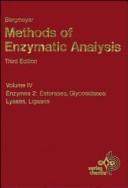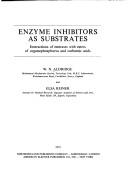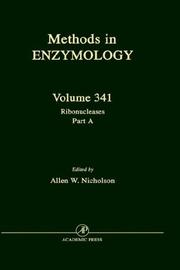| Listing 1 - 10 of 21 | << page >> |
Sort by
|
Book
ISBN: 0444887075 Year: 1991 Publisher: Amsterdam ; New York, NY : Elsevier,
Abstract | Keywords | Export | Availability | Bookmark
 Loading...
Loading...Choose an application
- Reference Manager
- EndNote
- RefWorks (Direct export to RefWorks)
Insecticides --- Insecticides --- Environmental impact --- Environmental impact --- toxicity --- toxicity --- birds --- birds --- mammals --- mammals --- pesticidal properties --- pesticidal properties --- ecosystems --- ecosystems --- residues --- residues --- Fauna --- Fauna --- Malathion --- Malathion --- Methiocarb --- Methiocarb --- Cholinesterase --- Cholinesterase --- Brain --- Brain --- Benomyl. --- Benomyl --- Organophosphorus compounds --- Organophosphorus compounds --- Poisson --- Cholinesterase inhibitor --- Substance indicatrice --- Serum b esterase --- Residu organophosphore --- Poisson --- Cholinesterase inhibitor --- Substance indicatrice --- Serum b esterase --- Residu organophosphore
Book
ISBN: 3039217097 3039217089 Year: 2019 Publisher: MDPI - Multidisciplinary Digital Publishing Institute
Abstract | Keywords | Export | Availability | Bookmark
 Loading...
Loading...Choose an application
- Reference Manager
- EndNote
- RefWorks (Direct export to RefWorks)
Biocatalysis, that is, the use of biological catalysts (enzymes, cells, etc.) for the preparation of highly valuable compounds is undergoing a great development, being considered an extremely sustainable approach to undertaking environmental demands. In this scenario, this book illustrates the versatility of applied biocatalysis for the preparation of drugs and other bioactive compounds through the presentation of different research articles and reviews, in which several authors describe the most recent developments in this appealing scientific area. By reading the excellent contributions gathered in this book, it is possible to have an updated idea about new advances and possibilities for a new exciting future.
n/a --- biotransformations --- glycosidases --- bacteria --- OcUGT1 --- antioxidant activity --- glycodiverfication --- benzoxathiepins --- coprostanol --- 7-methylguanosine iodide --- sulfuretin --- chondroitin sulfates --- 7-methylguanine arabinoside iodide --- 7-methyl-2?-deoxyguanosine iodide --- microalgae --- chitosan oligosaccharides --- deacetylation degree --- cholesterol --- Tecadenoson --- esterase --- metabolic pathways --- chitinases --- alcohol --- transglycosylation reaction --- MALDI-TOF --- photooxidation --- aqueous solubility --- ?-transaminase --- cascade --- nutraceutical --- antimuscarinic agents --- extraction --- rutin oligomers --- Alcalase® --- HPSEC --- Cladribine --- purine nucleoside phosphorylase --- pleiotropic effects --- biotransamination --- amino acid --- stereoselective --- laccase activity --- biocatalysis --- Ribavirin --- lyases --- chitosanases --- anti-inflammatory --- glycosaminoglycan --- polysaccharides --- amine transaminases --- ester hydrolysis --- Spirulina --- asymmetric synthesis --- reductive amination --- glycosyltransferase --- statins --- stereoselective synthesis --- xanthine oxidase inhibition --- reduction reaction --- pig liver esterase (PLE)

ISBN: 3527260447 Year: 1984 Volume: 4 Publisher: Weinheim : VCH,
Abstract | Keywords | Export | Availability | Bookmark
 Loading...
Loading...Choose an application
- Reference Manager
- EndNote
- RefWorks (Direct export to RefWorks)
Estérase --- Esterases --- Glycosidase --- Glycosidases --- Lyase --- Lyases --- Ligase --- Ligases --- Activité enzymatique --- Enzyme activity --- Analyse biologique --- Biological analysis --- Enzymes --- 577.15.088 --- analysis. --- Enzymes. Catalysts of biological reactions. Enzymology--?.088 --- ENZYMES --- analysis, laboratory manuals --- analysis, laboratory manuals. --- 577.15.088 Enzymes. Catalysts of biological reactions. Enzymology--?.088 --- Analysis, laboratory manuals. --- analysis --- Enzymology

ISBN: 0444103910 0720471265 9780720471267 Year: 1972 Volume: 26 Publisher: Amsterdam : North-Holland,
Abstract | Keywords | Export | Availability | Bookmark
 Loading...
Loading...Choose an application
- Reference Manager
- EndNote
- RefWorks (Direct export to RefWorks)
Carbamates. --- Esterases. --- Organophosphorus Compounds. --- Enzyme inhibitors. --- Organophosphorus compounds. --- Carbamic acid. --- Antienzymes --- Estérases --- Composés organophosphorés --- Carbamique, Acide --- Basic Sciences. Chemistry --- Biochemistry --- Proteins and Enzymes --- Proteins and Enzymes. --- Organopyrophosphorus Compounds --- Compounds, Organophosphorus --- Compounds, Organopyrophosphorus --- Phosphorus --- Phosphorus Compounds --- Aminoformic Acids --- Carbamic Acids --- Acids, Aminoformic --- Acids, Carbamic --- Estérases --- Composés organophosphorés --- Organophosphorus Compound --- Organopyrophosphorus Compound --- Compound, Organophosphorus --- Compound, Organopyrophosphorus --- Esterase --- Carbamate --- Carbamates --- Esterases --- Organophosphorus Compounds

ISSN: 00766879 ISBN: 0121822427 0121822435 9786611020859 1281020850 0080522572 9786611011208 1281011207 0080496911 9780121822439 9780121822422 Year: 2001 Volume: 341-342 Publisher: San Diego ; London : Academic Press,
Abstract | Keywords | Export | Availability | Bookmark
 Loading...
Loading...Choose an application
- Reference Manager
- EndNote
- RefWorks (Direct export to RefWorks)
This second volume on ribonucleases provides up-to-date, methods-related information on these enzymes. Of particular interest to researchers will be the discussion of artificial and engineered ribonucleases, as well as the application of ribonucleases in medicine and biotechnology.The critically acclaimed laboratory standard for more than forty years, Methods in Enzymology is one of the most highly respected publications in the field of biochemistry. Since 1955, each volume has been eagerly awaited, frequently consulted, and praised by researchers and reviewers alike. Now with more
Enzymology. --- Ribonucleases. --- RNA. --- Exoribonucleases --- Ribonucleases --- Endoribonucleases --- Esterases --- Exonucleases --- Endonucleases --- Hydrolases --- Enzymes --- Enzymes and Coenzymes --- Chemicals and Drugs --- Nucleases. --- Coenzymes and Enzymes --- Biocatalysts --- Acid Ribonuclease --- Alkaline Ribonuclease --- Ribonuclease --- Nucleases, RNA --- RNase --- RNA Nucleases --- Ribonuclease, Acid --- Ribonuclease, Alkaline --- RNases --- Nucleases --- Molecular Mechanisms of Pharmacological Action --- Biocatalyst --- Enzyme --- Hydrolase --- Esterase
Book
Year: 2022 Publisher: Basel MDPI - Multidisciplinary Digital Publishing Institute
Abstract | Keywords | Export | Availability | Bookmark
 Loading...
Loading...Choose an application
- Reference Manager
- EndNote
- RefWorks (Direct export to RefWorks)
The recent global events of the SARS-CoV-2 pandemic in 2020 have alerted the world to the urgent need to develop fast, sensitive, simple, and inexpensive analytical tools that are capable of carrying out a large number of quantitative analyses, not only in centralized laboratories and core facilities but also on site and for point-of-care applications. In particular, in the case of immunological tests, the required sensitivity and specificity is often lacking when carrying out large-scale screening using decentralized methods, while a centralized laboratory with qualified personnel is required for providing quantitative and reliable responses. The advantages typical of electrochemical and optical biosensors (low cost and easy transduction) can nowadays be complemented in terms of improved sensitivity by combining electrochemistry (EC) with optical techniques such as electrochemiluminescence (ECL), EC/surface-enhanced Raman spectroscopy (SERS), and EC/surface plasmon resonance (SPR). This Special Issue addresses existing knowledge gaps and aids in exploring new approaches, solutions, and applications for opto-electrochemical biosensors in the quantitative detection of disease markers, such as cancer biomarkers proteins and allergens, and pathogenic agents such as viruses. Included are seven peer-reviewed papers that cover a range of subjects and applications related to the strategies developed for early diagnosis.
Research & information: general --- Biology, life sciences --- Biochemistry --- gold nanoparticles --- doxycycline --- tetracycline --- SPR biosensor --- signal amplification --- clinical diagnosis --- microRNA --- electrochemical biosensor --- catalysts --- RedOx indicator --- cancer biomarker --- electrochemical immune platform --- human ST2 --- plasma --- pancreatic cancer --- collagen type I --- 4,4'-thiobisbenzenethiol --- nanogold --- electrochemical impedance spectroscopy --- surface plasmon resonance --- half antibody --- medical diagnostic devices --- peptide --- antifouling --- protease --- biomarker --- bioreceptor --- SARS-CoV-2 detection --- nasopharyngeal swab --- saliva --- serum --- droplets --- amperometric biosensor --- neural esterase --- acetylcholinesterase --- inhibition --- organophosphate --- design --- optimization --- mathematical model --- flux control --- dimensionless --- gold nanoparticles --- doxycycline --- tetracycline --- SPR biosensor --- signal amplification --- clinical diagnosis --- microRNA --- electrochemical biosensor --- catalysts --- RedOx indicator --- cancer biomarker --- electrochemical immune platform --- human ST2 --- plasma --- pancreatic cancer --- collagen type I --- 4,4'-thiobisbenzenethiol --- nanogold --- electrochemical impedance spectroscopy --- surface plasmon resonance --- half antibody --- medical diagnostic devices --- peptide --- antifouling --- protease --- biomarker --- bioreceptor --- SARS-CoV-2 detection --- nasopharyngeal swab --- saliva --- serum --- droplets --- amperometric biosensor --- neural esterase --- acetylcholinesterase --- inhibition --- organophosphate --- design --- optimization --- mathematical model --- flux control --- dimensionless
Book
ISBN: 1281117145 9786611117146 1402065612 1402065604 9048176700 Year: 2008 Publisher: Dordrecht : Springer,
Abstract | Keywords | Export | Availability | Bookmark
 Loading...
Loading...Choose an application
- Reference Manager
- EndNote
- RefWorks (Direct export to RefWorks)
Research into the paraoxonase (PON) multigene family has really only blossomed in the last 10 years. Before this time only PON1 was known and research was restricted to toxicologists investigating the metabolism of organophosphate insecticides and nerve gases and a few “mad” scientists searching for “natural” substrates. Since this time two new members PON2 and PON3 have been discovered, all 3 PONs have been shown to act as antioxidants and the PON family has taken centre stage as major players in the development of a wide variety of diseases such as cardiovascular disease, diabetes mellitus, rheumatism, Alzheimer and many more while remaining important in determining organophosphate toxicity. In September 2006 the 2nd International Conference on Paraoxonases took place in Hajdúszoboszló, Hungary, bringing together the world's foremost experts in the field. The current book is a distillation of the plenary lectures which took place at the meeting, resulting in a comprehensive up to date, state of the art review of current paraoxonase research.
Paraoxonase --- Biochemistry. --- Biological chemistry --- Chemical composition of organisms --- Organisms --- Physiological chemistry --- Biology --- Chemistry --- Medical sciences --- Aromatic esterase --- Arylesterase --- Esterases --- Composition --- Internal medicine. --- Cardiology. --- Diabetes. --- Metabolic diseases. --- Internal Medicine. --- Metabolic Diseases. --- Medical Biochemistry. --- Disorders of metabolism --- Metabolic diseases --- Metabolic disorders --- Metabolism, Disorders of --- Diseases --- Brittle diabetes --- Diabetes mellitus --- IDDM (Disease) --- Insulin-dependent diabetes --- Ketosis prone diabetes --- Type 1 diabetes --- Carbohydrate intolerance --- Endocrine glands --- Diabetic acidosis --- Glycosylated hemoglobin --- Heart --- Internal medicine --- Medicine, Internal --- Medicine --- Medical biochemistry. --- Medical biochemistry --- Pathobiochemistry --- Pathological biochemistry --- Biochemistry --- Pathology
Book
ISBN: 1872748007 Year: 1991 Publisher: Oxford Blackwell
Abstract | Keywords | Export | Availability | Bookmark
 Loading...
Loading...Choose an application
- Reference Manager
- EndNote
- RefWorks (Direct export to RefWorks)
Molecular biology --- Biologie moléculaire --- Laboratoire --- laboratories --- Enzymes --- Bacteria --- Bacteriophages --- Plasmide --- plasmids --- Clonage --- cloning --- genomes --- genes --- Électrophorèse --- Electrophoresis --- Hybridation --- Hybridization --- Centrifugation --- Centrifuging --- Sécurité --- safety --- Méthylation --- Methylation --- ADN --- DNA --- Nucléase --- Nucleases --- Estérase --- Esterases --- GENETIC TECHNIQUES --- MICROBIOLOGICAL TECHNIQUES --- tables --- outlines --- tables. --- outlines. --- Genetic techniques --- Microbiological techniques --- Tables. --- Outlines. --- Biologie moléculaire --- Centrifuging. --- Methylation. --- DNA. --- Restriction --- Arn polymerase --- Topoisomerase --- BACTERIA --- VIRUS, BACTERIAL --- RADIOELEMENTS --- MOLECULAR CLONING --- GENES --- ENZYMES --- ELECTROPHORESIS --- CENTRIFUGATION --- SAFETY --- BIOLOGICAL STUDIES
Book
Year: 2022 Publisher: Basel MDPI - Multidisciplinary Digital Publishing Institute
Abstract | Keywords | Export | Availability | Bookmark
 Loading...
Loading...Choose an application
- Reference Manager
- EndNote
- RefWorks (Direct export to RefWorks)
The recent global events of the SARS-CoV-2 pandemic in 2020 have alerted the world to the urgent need to develop fast, sensitive, simple, and inexpensive analytical tools that are capable of carrying out a large number of quantitative analyses, not only in centralized laboratories and core facilities but also on site and for point-of-care applications. In particular, in the case of immunological tests, the required sensitivity and specificity is often lacking when carrying out large-scale screening using decentralized methods, while a centralized laboratory with qualified personnel is required for providing quantitative and reliable responses. The advantages typical of electrochemical and optical biosensors (low cost and easy transduction) can nowadays be complemented in terms of improved sensitivity by combining electrochemistry (EC) with optical techniques such as electrochemiluminescence (ECL), EC/surface-enhanced Raman spectroscopy (SERS), and EC/surface plasmon resonance (SPR). This Special Issue addresses existing knowledge gaps and aids in exploring new approaches, solutions, and applications for opto-electrochemical biosensors in the quantitative detection of disease markers, such as cancer biomarkers proteins and allergens, and pathogenic agents such as viruses. Included are seven peer-reviewed papers that cover a range of subjects and applications related to the strategies developed for early diagnosis.
gold nanoparticles --- doxycycline --- tetracycline --- SPR biosensor --- signal amplification --- clinical diagnosis --- microRNA --- electrochemical biosensor --- catalysts --- RedOx indicator --- cancer biomarker --- electrochemical immune platform --- human ST2 --- plasma --- pancreatic cancer --- collagen type I --- 4,4′-thiobisbenzenethiol --- nanogold --- electrochemical impedance spectroscopy --- surface plasmon resonance --- half antibody --- medical diagnostic devices --- peptide --- antifouling --- protease --- biomarker --- bioreceptor --- SARS-CoV-2 detection --- nasopharyngeal swab --- saliva --- serum --- droplets --- amperometric biosensor --- neural esterase --- acetylcholinesterase --- inhibition --- organophosphate --- design --- optimization --- mathematical model --- flux control --- dimensionless --- n/a --- 4,4'-thiobisbenzenethiol
Book
Year: 2022 Publisher: Basel MDPI - Multidisciplinary Digital Publishing Institute
Abstract | Keywords | Export | Availability | Bookmark
 Loading...
Loading...Choose an application
- Reference Manager
- EndNote
- RefWorks (Direct export to RefWorks)
The recent global events of the SARS-CoV-2 pandemic in 2020 have alerted the world to the urgent need to develop fast, sensitive, simple, and inexpensive analytical tools that are capable of carrying out a large number of quantitative analyses, not only in centralized laboratories and core facilities but also on site and for point-of-care applications. In particular, in the case of immunological tests, the required sensitivity and specificity is often lacking when carrying out large-scale screening using decentralized methods, while a centralized laboratory with qualified personnel is required for providing quantitative and reliable responses. The advantages typical of electrochemical and optical biosensors (low cost and easy transduction) can nowadays be complemented in terms of improved sensitivity by combining electrochemistry (EC) with optical techniques such as electrochemiluminescence (ECL), EC/surface-enhanced Raman spectroscopy (SERS), and EC/surface plasmon resonance (SPR). This Special Issue addresses existing knowledge gaps and aids in exploring new approaches, solutions, and applications for opto-electrochemical biosensors in the quantitative detection of disease markers, such as cancer biomarkers proteins and allergens, and pathogenic agents such as viruses. Included are seven peer-reviewed papers that cover a range of subjects and applications related to the strategies developed for early diagnosis.
Research & information: general --- Biology, life sciences --- Biochemistry --- gold nanoparticles --- doxycycline --- tetracycline --- SPR biosensor --- signal amplification --- clinical diagnosis --- microRNA --- electrochemical biosensor --- catalysts --- RedOx indicator --- cancer biomarker --- electrochemical immune platform --- human ST2 --- plasma --- pancreatic cancer --- collagen type I --- 4,4′-thiobisbenzenethiol --- nanogold --- electrochemical impedance spectroscopy --- surface plasmon resonance --- half antibody --- medical diagnostic devices --- peptide --- antifouling --- protease --- biomarker --- bioreceptor --- SARS-CoV-2 detection --- nasopharyngeal swab --- saliva --- serum --- droplets --- amperometric biosensor --- neural esterase --- acetylcholinesterase --- inhibition --- organophosphate --- design --- optimization --- mathematical model --- flux control --- dimensionless --- n/a --- 4,4'-thiobisbenzenethiol
| Listing 1 - 10 of 21 | << page >> |
Sort by
|

 Search
Search Feedback
Feedback About UniCat
About UniCat  Help
Help News
News